Reading stations: A transitional activity to extensive reading
Extensive Reading (ER) is a method that allows students to read widely and easily in various
topics, primarily for pleasure and general understanding. To introduce ER to the current reading
curriculum, an experimental, transitional activity called Reading Station was conducted in two Reading
4 classes in English Department of Hue University, in which students were asked to collect and share
online English articles with each other during the class time. Questionnaire and focused-group
discussion’s results based on 7-week practice revealed that students showed great interest in the activity
and claimed to see certain impacts of this activity on the improvement of knowledge and skills. The
study’s positive outcome implies the potential of using similar activities to solve various challenges in
traditional Reading classes.

Trang 1
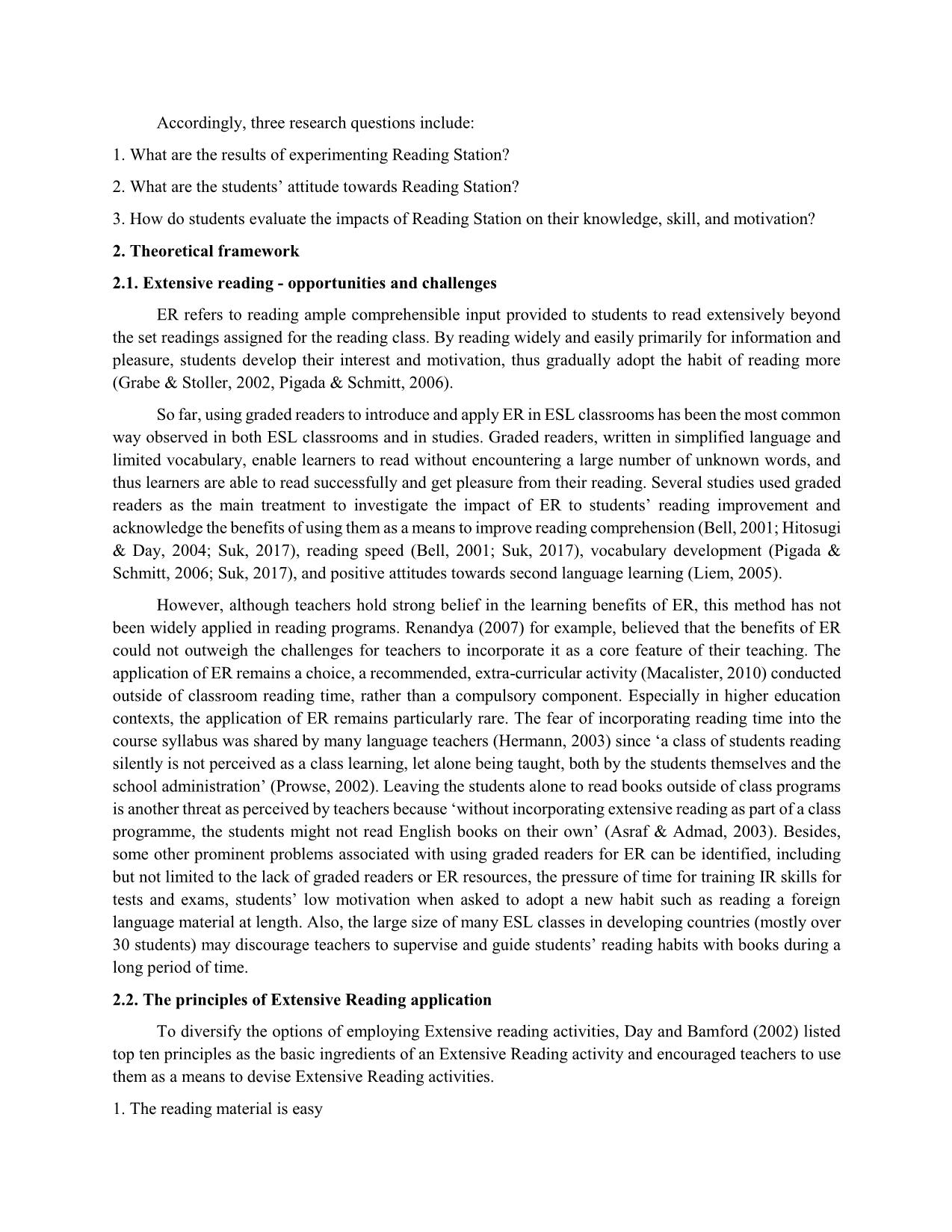
Trang 2
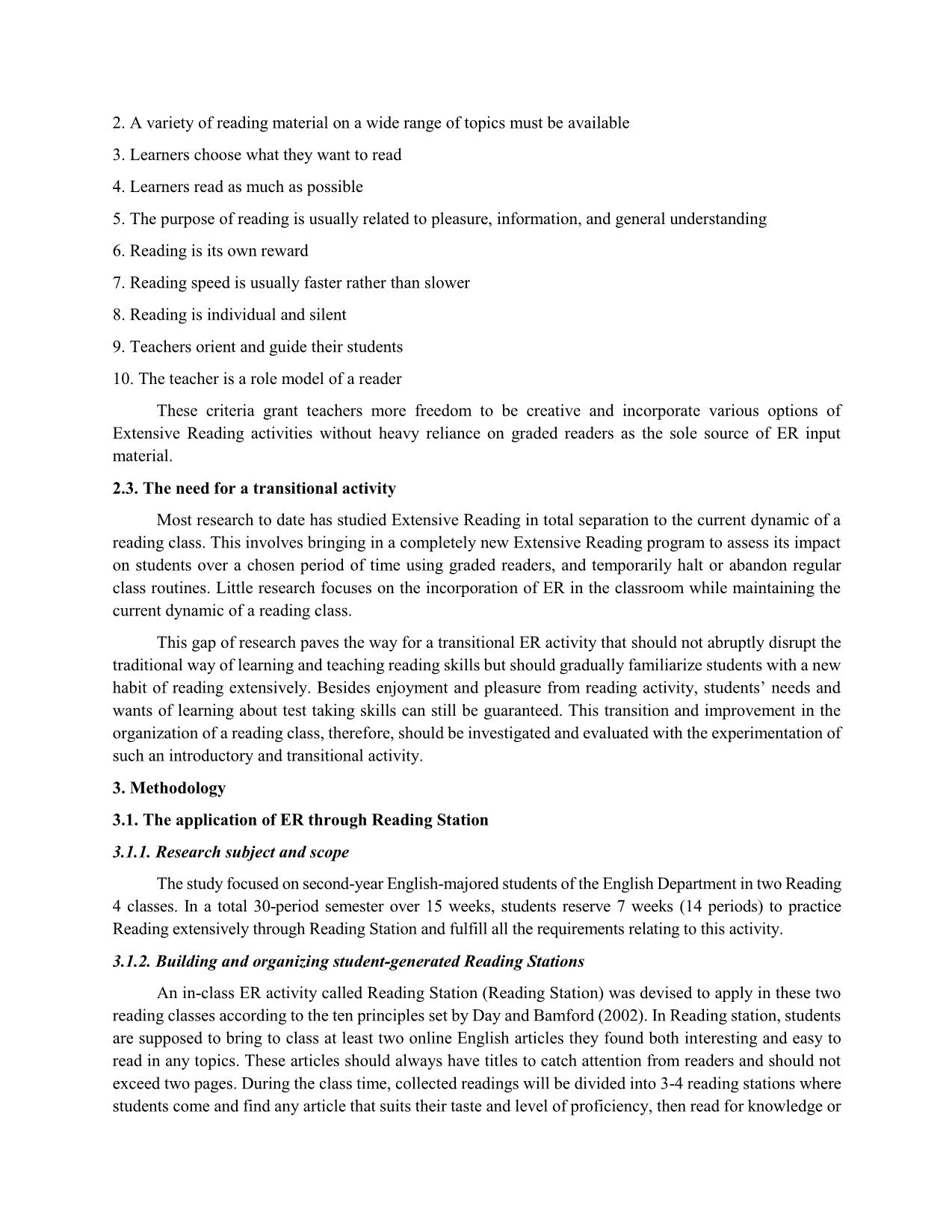
Trang 3
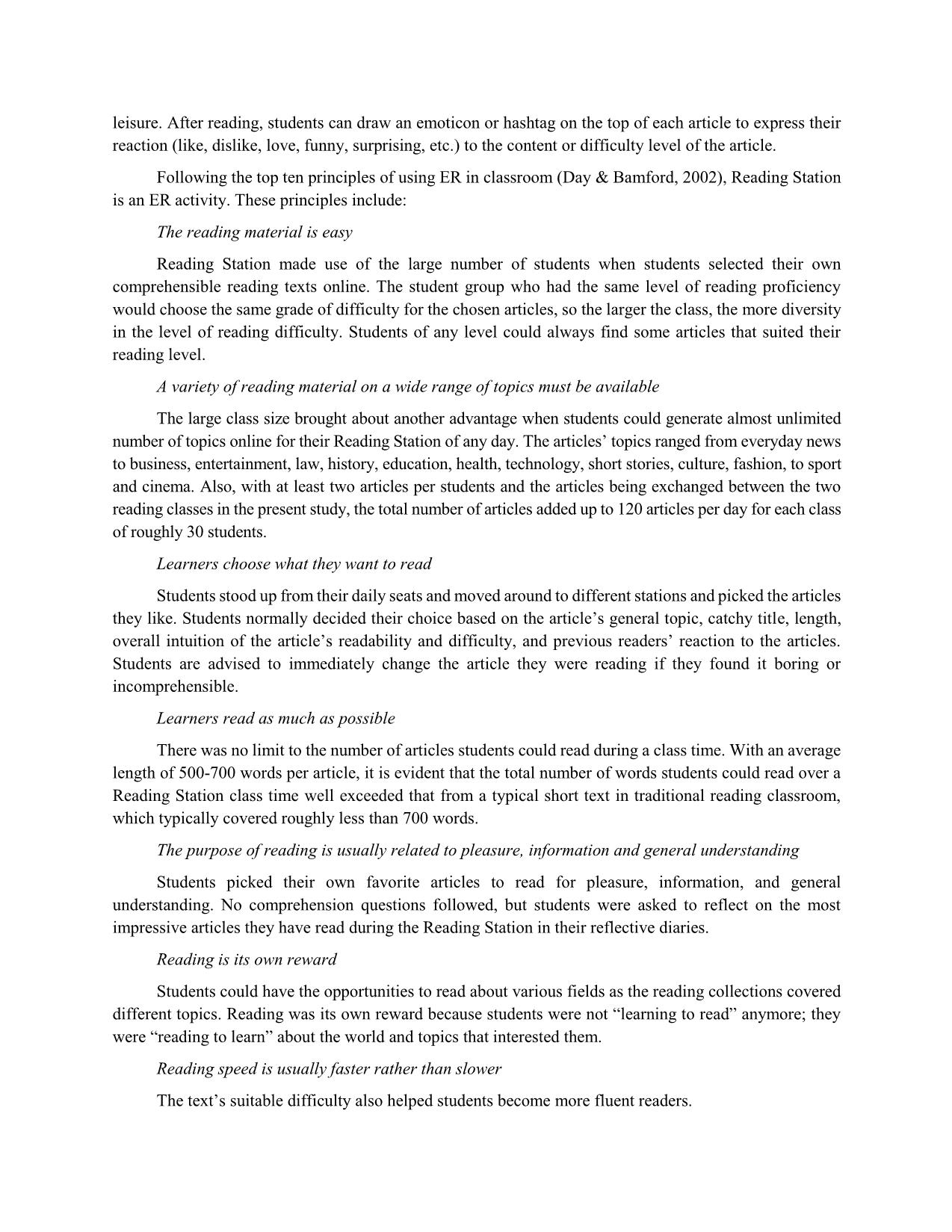
Trang 4
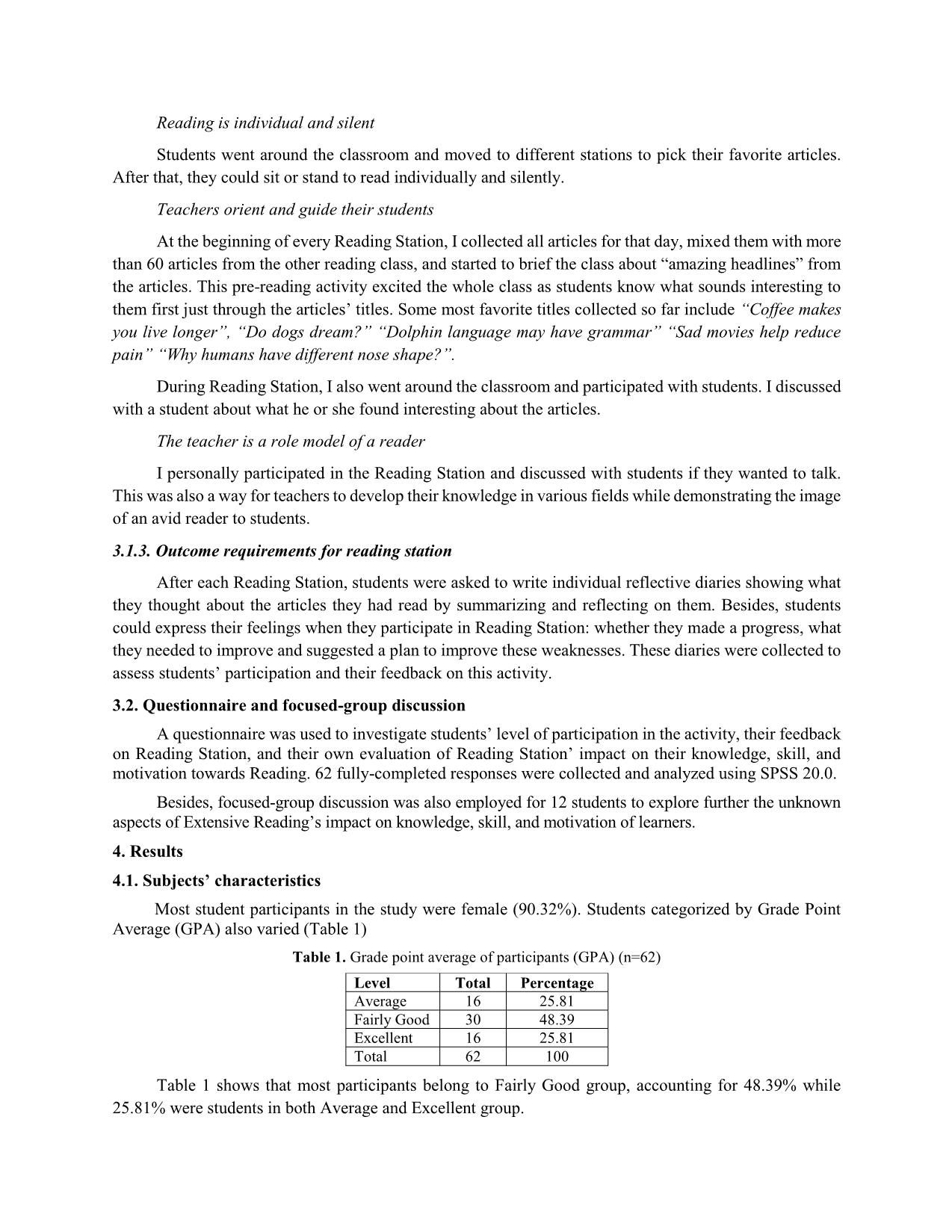
Trang 5
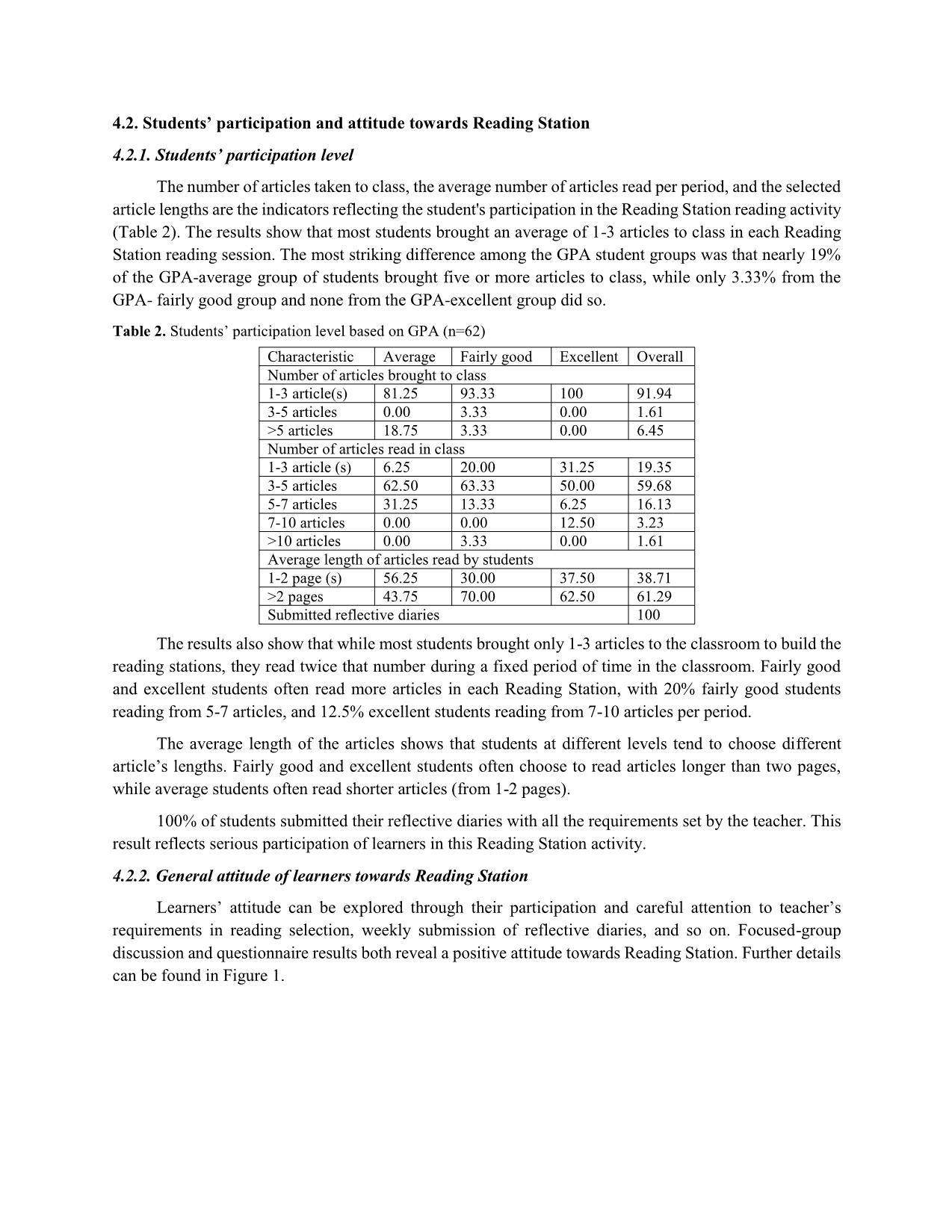
Trang 6
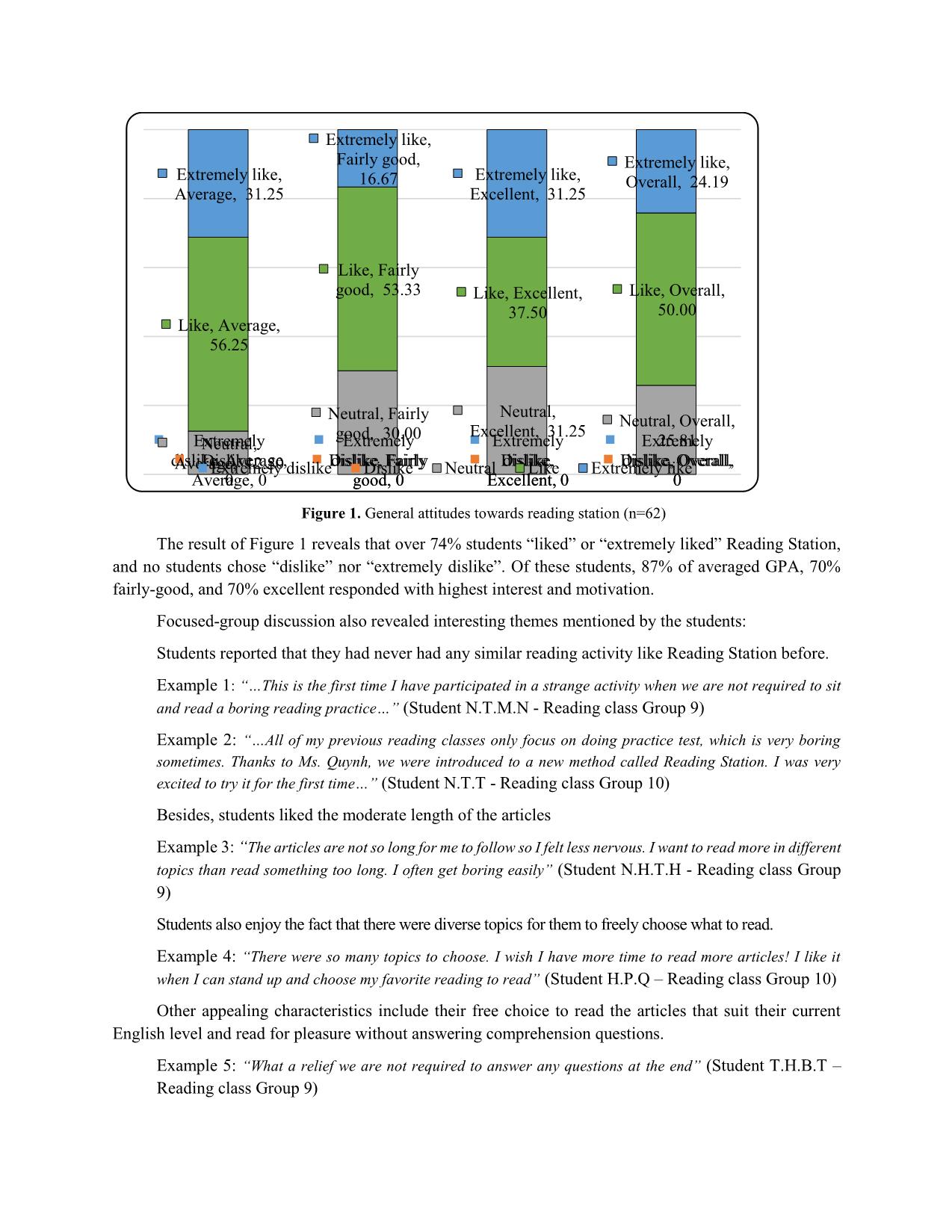
Trang 7
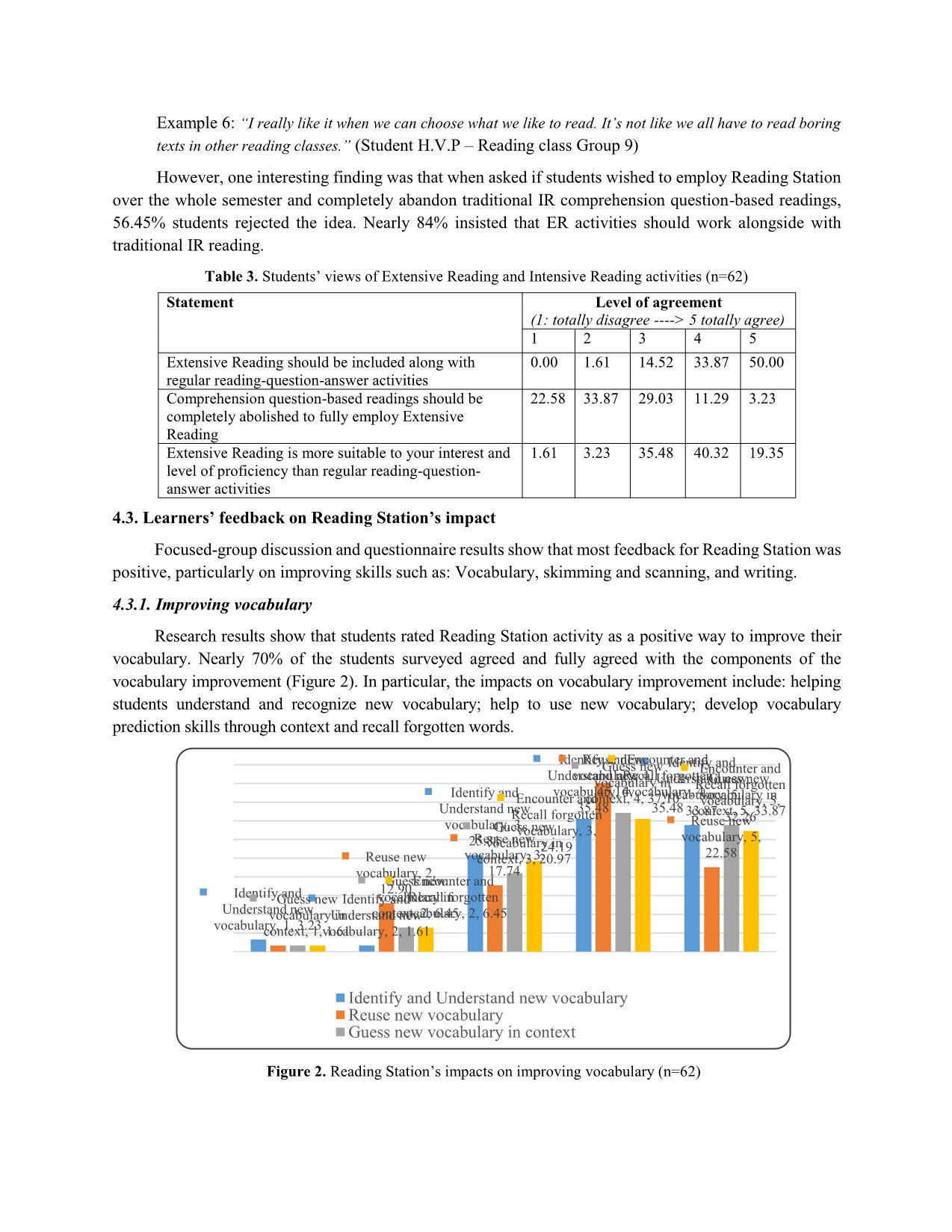
Trang 8
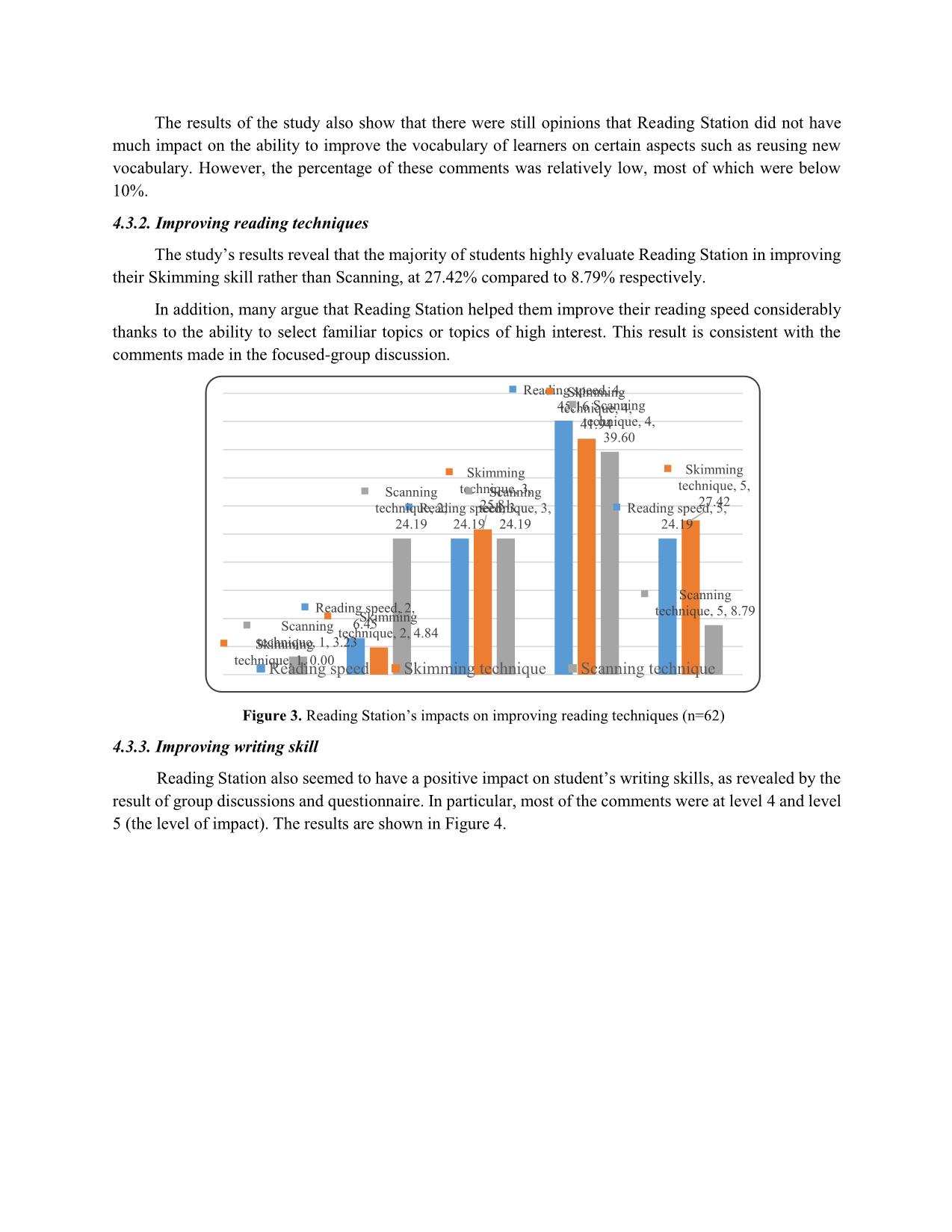
Trang 9
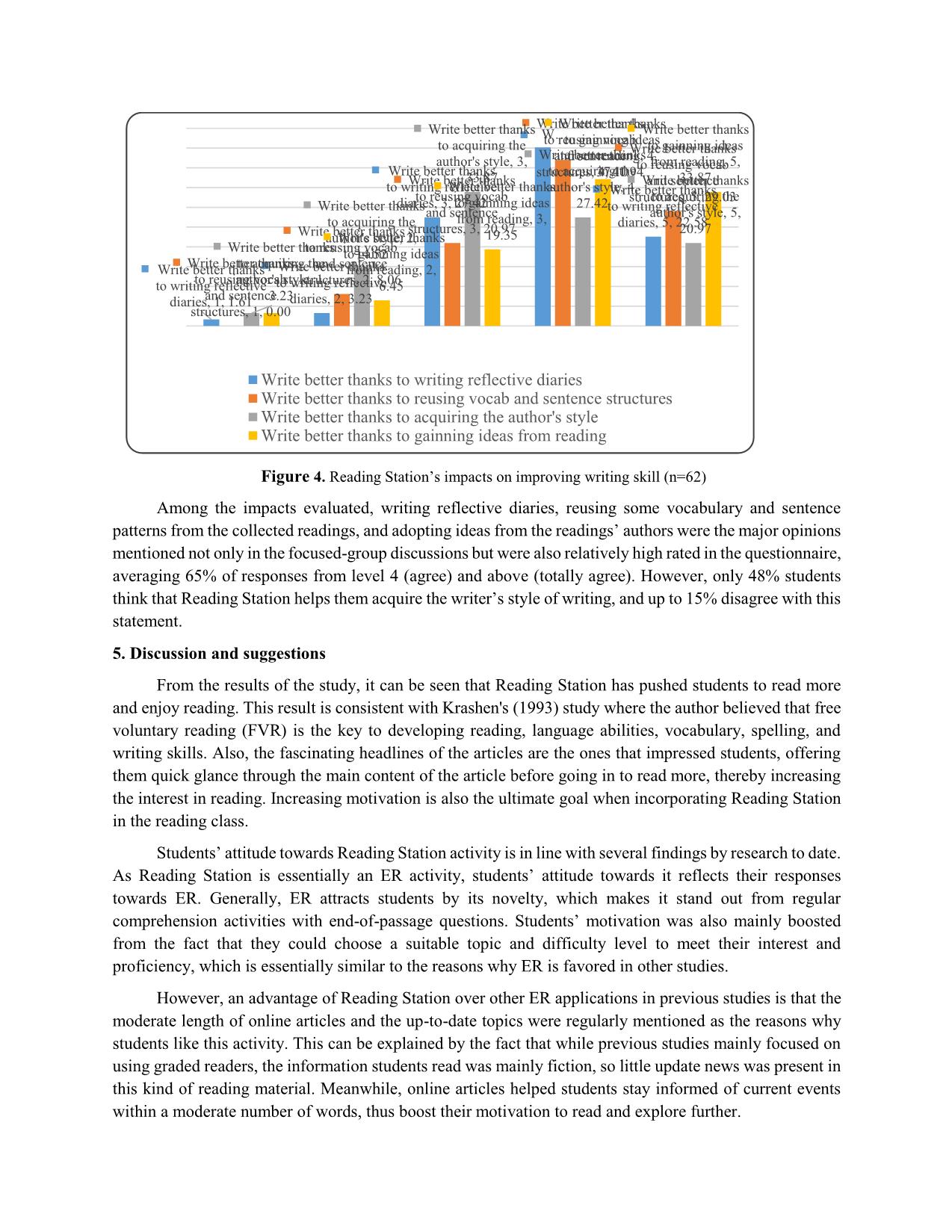
Trang 10
Tải về để xem bản đầy đủ
Tóm tắt nội dung tài liệu: Reading stations: A transitional activity to extensive reading
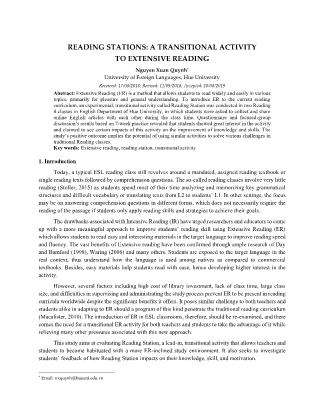
ncounter and Recall forgotten vocabulary, 3, 24.19 Encounter and Recall forgotten vocabulary, 4, 35.48 Encounter and Recall forgotten vocabulary, 5, 32.26 Identify and Understand new vocabulary Reuse new vocabulary Guess new vocabulary in context The results of the study also show that there were still opinions that Reading Station did not have much impact on the ability to improve the vocabulary of learners on certain aspects such as reusing new vocabulary. However, the percentage of these comments was relatively low, most of which were below 10%. 4.3.2. Improving reading techniques The study’s results reveal that the majority of students highly evaluate Reading Station in improving their Skimming skill rather than Scanning, at 27.42% compared to 8.79% respectively. In addition, many argue that Reading Station helped them improve their reading speed considerably thanks to the ability to select familiar topics or topics of high interest. This result is consistent with the comments made in the focused-group discussion. Figure 3. Reading Station’s impacts on improving reading techniques (n=62) 4.3.3. Improving writing skill Reading Station also seemed to have a positive impact on student’s writing skills, as revealed by the result of group discussions and questionnaire. In particular, most of the comments were at level 4 and level 5 (the level of impact). The results are shown in Figure 4. Reading speed, 2, 6.45 Reading speed, 3, 24.19 Reading speed, 4, 45.16 Reading speed, 5, 24.19 Skimming technique, 1, 0.00 Skimming technique, 2, 4.84 Skimming technique, 3, 25.81 Skimming technique, 4, 41.94 Skimming technique, 5, 27.42 Scanning technique, 1, 3.23 Scanning technique, 2, 24.19 Scanning t chnique, 3, 24.19 Scanning technique, 4, 39.60 Scanning technique, 5, 8.79 Reading speed Skimming technique Scanning technique Figure 4. Reading Station’s impacts on improving writing skill (n=62) Among the impacts evaluated, writing reflective diaries, reusing some vocabulary and sentence patterns from the collected readings, and adopting ideas from the readings’ authors were the major opinions mentioned not only in the focused-group discussions but were also relatively high rated in the questionnaire, averaging 65% of responses from level 4 (agree) and above (totally agree). However, only 48% students think that Reading Station helps them acquire the writer’s style of writing, and up to 15% disagree with this statement. 5. Discussion and suggestions From the results of the study, it can be seen that Reading Station has pushed students to read more and enjoy reading. This result is consistent with Krashen's (1993) study where the author believed that free voluntary reading (FVR) is the key to developing reading, language abilities, vocabulary, spelling, and writing skills. Also, the fascinating headlines of the articles are the ones that impressed students, offering them quick glance through the main content of the article before going in to read more, thereby increasing the interest in reading. Increasing motivation is also the ultimate goal when incorporating Reading Station in the reading class. Students’ attitude towards Reading Station activity is in line with several findings by research to date. As Reading Station is essentially an ER activity, students’ attitude towards it reflects their responses towards ER. Generally, ER attracts students by its novelty, which makes it stand out from regular comprehension activities with end-of-passage questions. Students’ motivation was also mainly boosted from the fact that they could choose a suitable topic and difficulty level to meet their interest and proficiency, which is essentially similar to the reasons why ER is favored in other studies. However, an advantage of Reading Station over other ER applications in previous studies is that the moderate length of online articles and the up-to-date topics were regularly mentioned as the reasons why students like this activity. This can be explained by the fact that while previous studies mainly focused on using graded readers, the information students read was mainly fiction, so little update news was present in this kind of reading material. Meanwhile, online articles helped students stay informed of current events within a moderate number of words, thus boost their motivation to read and explore further. Write better thanks to writing reflective diaries, 1, 1.61 Write better thanks to writing reflective diaries, 2, 3.23 Write better thanks to writing reflective diaries, 3, 27.42 W Write better thanks to writing reflective diaries, 5, 22.58 Write better thanks to reusing vocab and sentence structures, 1, 0.00 Write better thanks to reusing vocab and sentence structures, 2, 8.06 Write better thanks to reusing vocab and sentence structures, 3, 20.97 Write better thanks to reusing vocab and sentence structures, 4, 41.94 Write better thanks to reusing vocab and sentence structures, 5, 29.03 Write better thanks to acquiring the auth r's style, 1, 3.23 Write better thanks to acquiring the author's style, 2, 14.52 Write better thanks to acquiring the author's style, 3, 33.87 Write better thanks to acquiring the author's style, 4, 27.42 Write be ter thanks to acquiring the author's style, 5, 20.97 Write bett r thanks to gainning ideas from reading, 2, 6.45 Write b tter thanks to gainning ideas from reading, 3, 19.35 Write be ter thanks to gainning ideas from r adi g, 4, 37.10 Write better thanks to gainning ideas from reading, 5, 33.87 Write better thanks to writing reflective diaries Write better thanks to reusing vocab and sentence structures Write better thanks to acquiring the author's style Write better thanks to gainning ideas from reading With regards to improving vocabulary, the present study found out that students claimed they saw clear improvement in various aspects of vocabulary development. Studies by Pigada and Schmitt (2006) and Nation and Ming-Tzu (1999) also suggest that the ER really helps learners understand the meaning and grammatical aspects of the word, thereby raising the awareness to use better vocabulary in Writing. Another study by Yamashita (2008) also found that students after being exposed to ER could use vocabulary and structure that often appear in the reading materials. In the present study, these findings were confirmed as nearly 70% of students think that the ER helps to expand the receptive and productive vocabulary. Meanwhile, nearly 13% of respondents still claimed that Reading Station did not have much impact on learners’ ability to use the acquired vocabulary in productive skills, and this can be explained by Huckin and Coady (1999)'s study. They argued that the benefits of improving vocabulary by ER were not so significant because learning vocabulary by this way was not intentional, so learners can hardly remember new words for a long time. This will prevent students from reusing the vocabulary found in the readings, because by the time they write, the learner will no longer remember to use unintentionally learned words. Regarding the development of reading techniques, the practice of Reading Station was claimed to improve Skimming more than Scanning. This can be explained by the fact that the main purpose of ER is to read for joy and general understanding, without focusing on locating specific information for a comprehension-detail question. This result corresponds to Sun's (2003) study when he only explored the Skimming for Gist process in detail in a similar activity called Extensive Reading Online (ERO) and barely mentioned the Scanning technique. According to Sun (2003), students entered the reading phases by skimming the titles and subtitles, the topic sentences of each section to try to understand the main content of the article. These steps were also employed by students in the present study when all students approached an article by reading its catchy title first. Finally, for the improvement of writing skills, the results are consistent with those of Macalister (2010), Soliman (2012) who suggested that students write better by applying some words and sentence structures gained from reading. Reading these up-to-date articles also helps them learn better ideas for later writing activities. From the results and discussions above, the incorporation of ER using online English articles to current IR-based English reading classes is well suited to the practical context and solidifies the theoretical framework of ER and its benefits. Extensive reading in general and similar activities to Reading Station should complement traditional reading strategies in classroom instruction to stimulate students' interest in reading English and promote positive values of both methods. This is also a case study with initial positive results of how ER can be easily introduced in traditional IR classrooms at low cost, solving several problems and conflicts of integrating ER into the rigid reading curriculum. Despite employing a mixture of quantitative and qualitative methodology, a few limitations of the present study are worth pointing out. One limitation is that this study involves only initial evaluation of the transitional activity Reading Station, thus, is still on a small scale. Another is that it also sought to explore only students’ motivations and feedback without empirical evidence of their sub-skill improvement. Also, the study only looked at English-majored students and thus, could be of little implication to general English learners. Further research may investigate in-depth the impact of such introductory ER activity to students and/or compare the impacts of this transitional activity to complete ER program on a specific skill or part of knowledge. Reading Station activity can be further upgraded to an online version where information is stored over time, creating a bank of graded articles that can be used for later years. 6. Conclusion Reading Station activity in two Reading 4 classes at Hue University concluded with a positive outcome with regards to students’ motivation in reading extensively, and the perceived impacts on improving vocabulary, reading techniques, and writing skill. This activity proved to be a cost-efficient introduction to ER when certain restrictions that prevent the application of ER in reading classes were present. By abiding by the ten core principles of ER, teachers would be able to devise many other similar activities to Reading Station in the present study that suit the available teaching and learning conditions – an activity that balance students’ needs and wants. References Asraf, R.M., & Ahmad, I.S. (2003). Promoting English language development and the reading habit among students in rural schools through the guided extensive reading program. Reading in a Foreign Language, 15(2), 83. Bell, T. (2001). Extensive reading: Speed and comprehension. The Reading Matrix, 1(1). Day, R., & Bamford, J. (1998). Extensive reading in the second language classroom. Cambridge: Cambridge University Press. Day, R., & Bamford, J. (2002). Top ten principles for teaching extensive reading. Reading in a Foreign Language, 14(2), 136-141. Grabe, W., & Stoller, F. (2002). Teaching and researching reading. Harlow, UK: Longman. Hermann, F. (2003). Differential effects of reading and memorization of paired associates on vocabulary acquisition in adult learners of English as a second language. TESL-EJ, 7(1), 1-16. Hitosugi, C.I., & Day, R.R. (2004). Extensive reading in Japanese. Reading in a Foreign Language, 16(1), 20. Huckin, T., & Coady, J. (1999). Incidental vocabulary acquisition in a second language. Studies in Second Language Acquisition, 21(2), 181-193. Krashen, S. (1993). The power of reading. Libraries Unlimited, Englewood, CO. Liem, D.H. (2005). Using extensive reading to enhance students’ perceptions and their reading ability. Unpublished masters thesis. King Mongkut’s University of Technology. Bangkok, Thailand. Macalister, J. (2010). Investigating teacher attitudes to extensive reading practices in higher education: Why isn’t everyone doing it?. RELC Journal, 41(1), 59-75. Doi: https://doi.org/10.1177/00336882 10362609. Nation, P., & Ming-Tzu, K.W. (1999). Graded readers and vocabulary. Reading in a Foreign Language, 12(2), 355-380. Nunan, D. (2003). Practical English language teaching. New York: McGraw-Hill. Pigada, M., & Schmitt, N. (2006). Vocabulary acquisition from extensive reading: A case study. Reading in a Foreign Language, 18(1), 1-28. Doi: https://doi.org/10.1613/jair.301. Prowse, P. (2002). Top ten principles for teaching extensive reading: A response. Reading in a Foreign Language, 14(2), 142. Renandya, W.A. (2007). The power of extensive reading. RELC Journal, 38(2), 133-149. Doi : https://doi.org/10.1177/0033688207079578. Soliman, N.A. (2012). Integrating extensive reading and reading circles in ESL. International Journal of Global Education, 1(1), 26-34. Stoller, F.L. (2015). Viewing extensive reading from different vantage points. Reading in a Foreign Language, 27(1), 152-159. Suk, N. (2017). The effects of extensive reading on reading comprehension, reading rate, and vocabulary acquisition. Reading Research Quarterly, 52(1), 73-89. Doi: https://doi.org/10.1002/ rrq.152. Sun, Y.C. (2003). Extensive reading online: An overview and evaluation. Journal of Computer Assisted Learning, 19(4), 438-446. Waring, R. (2006). Why extensive reading should be an indispensable part of all language programmes. The Language Teacher, 30(7), 44-47. Yamashita, J. (2008). Extensive reading and development of different aspects of L2 proficiency. System, 36(4), 661-672. TRẠM ĐỌC - MỘT HOẠT ĐỘNG CHUYỂN TIẾP TRONG ĐỌC MỞ RỘNG TIẾNG ANH Tóm tắt: Đọc mở rộng (ĐMR) là phương pháp cho phép sinh viên đọc nhiều chủ đề khác nhau một cách dễ dàng vì niềm vui và hiểu biết chung. Để từng bước đưa ĐMR vào chương trình học đọc chính khóa, một hoạt động mang tính thử nghiệm và chuyển tiếp có tên Reading Station (RS) đã được tiến hành trong 2 lớp đọc 4 tại khoa tiếng Anh, Đại học Ngoại ngữ, Đạo học Huế. Ở đó sinh viên được yêu cầu mang các bài báo tiếng Anh đến lớp để chia sẻ và cùng đọc. Các kết quả thu thập được từ bảng hỏi và thảo luận nhóm người học cho thấy, sinh viên rất thích hoạt động này và đã chỉ ra những tác động tích cực của RS đến kiến thức và kỹ năng của họ. Kết quả này cho thấy tiềm năng ứng dụng các hoạt động tương tự trong dạy đọc tiếng Anh hiện nay. Từ khóa: Đọc mở rộng, trạm đọc, hoạt động chuyển tiếp
File đính kèm:
 reading_stations_a_transitional_activity_to_extensive_readin.pdf
reading_stations_a_transitional_activity_to_extensive_readin.pdf

